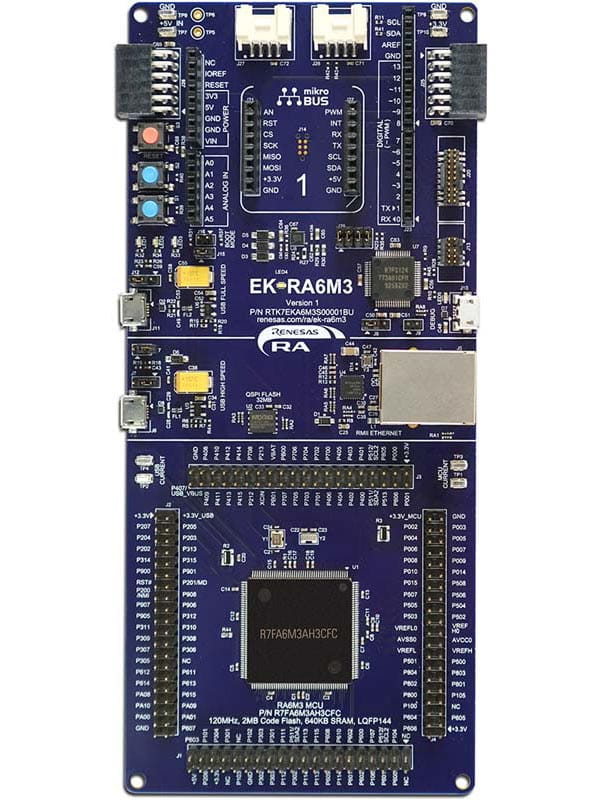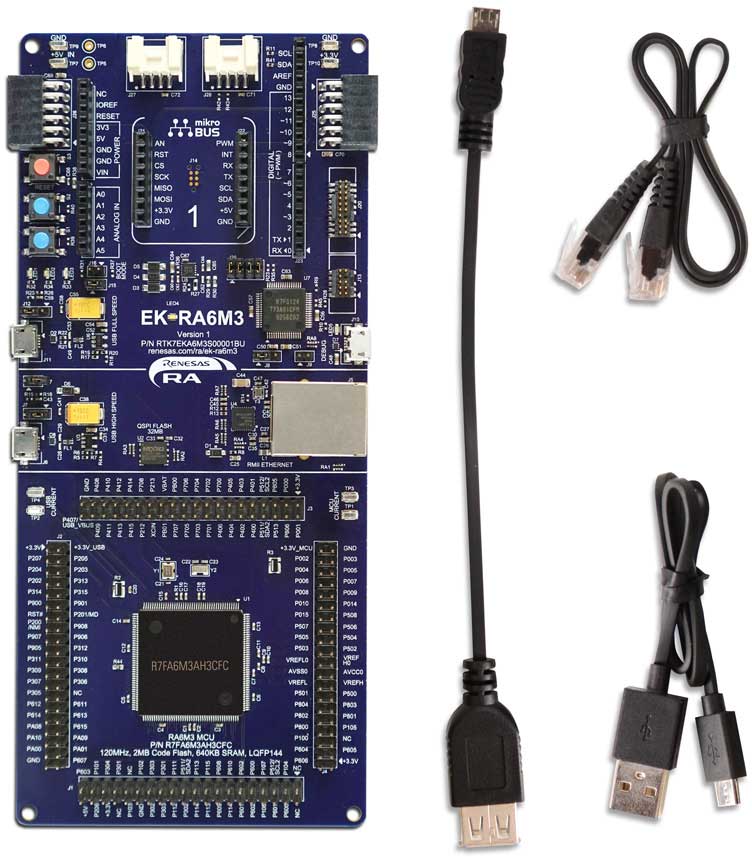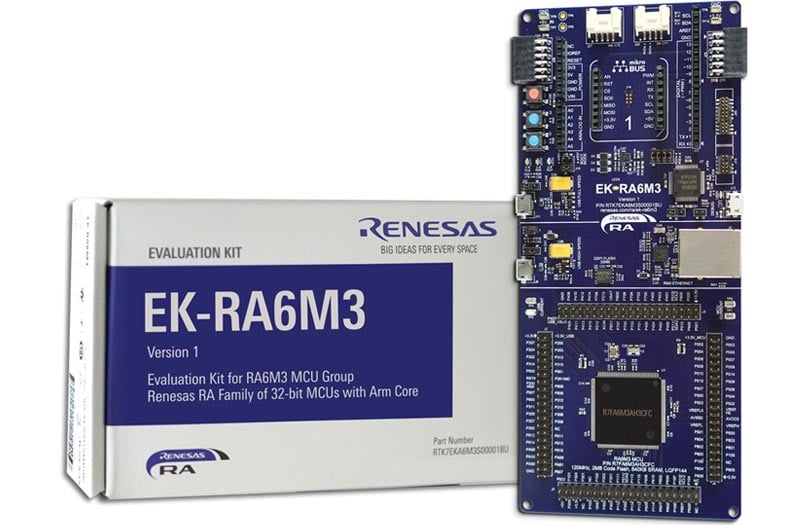Overview
Description
The EK-RA6M3 evaluation kit enables users to seamlessly evaluate the features of the RA6M3 MCU Group and develop embedded systems applications using the Flexible Software Package (FSP) and e2studio IDE. Utilize rich on-board features along with your choice of popular ecosystem add-ons to bring your big ideas to life.
Getting Started
Running the Quick Start Example Project
- The EK-RA6M3 comes pre-programmed with a Quick Start example project (Provided with the example projects bundle).
- Power up the EK-RA6M3 board through the debug USB port (J10) using the micro USB device cable connected to a 5V power source. The white power LED will light up.
- The Quick Start example project will begin to execute blinking the red, green and blue user LEDs.
- Refer to the EK-RA6M3 – Quick Start Guide (PDF) to explore additional functionality of the Quick Start example project.
Developing Embedded Applications
- Modifying the Quick Start example project – Refer to the EK-RA6M3 Quick Start Guide for instructions on importing, modifying, and building the Quick Start example project
- Start with one of the many other example projects (Provided in the example projects bundle) – Choose from many example projects to learn about different peripherals of the RA6M3 MCU Group. These example projects can serve as excellent starting points for you to develop your custom applications.
Building a Custom Hardware
- Start by building a functional prototype – Utilize the EK-RA6M3 board with your choice of hundreds of popular ecosystem add-ons.
- Build custom hardware – Develop custom hardware by referring to the design and manufacturing information provided in the EK-RA6M3v1 - Design Package (ZIP | English, 日本語)
Features
- Special Feature Access
- Ethernet (RMII and PHY)
- USB High Speed host and device
- 32MB External QSPI Flash
- MCU Native Pin Access
- R7FA6M3AH3CFC MCU
- 120MHz, Arm Cortex®-M4 core
- 2MB Code Flash, 640kB SRAM
- 176 pins, LQFP package
- Native pin access through 4x 40-pin male headers
- MCU and USB current measurement points
- Ecosystem & System Control Access
- USB Full Speed host and device
- Multiple 5V input sources
- USB (Debug, Full Speed, High Speed)
- External power supply
- SEGGER J-LinkTM on-board programmer and debugger
- Debug modes
- Debug On-board (SWD) – via J-Link
- Debug Out (SWD) – via J-Link
- Debug In (ETM, SWD & JTAG) – via J-Link, Arm® Keil® ULINKTM, IAR I-jetTM, Renesas E2/E2 Lite, etc.
- User LEDs and buttons
- Three user LEDs (red, blue, green)
- Power LED (white) indicating availability of regulated power
- Debug LED (yellow) indicating the debug connection
- Two user buttons
- One reset button
- Four most popular ecosystem expansions
- MikroElektronikaTM mikroBUSTM connector
- Two SeeedGrove® system (I2C) connectors
- Two Digilent PmodTM (SPI and UART) connectors
- ArduinoTM (Uno R3) connector
- MCU boot configuration jumper
Applications
Design & Development
Support

Support Communities
Get quick technical support online from Renesas Engineering Community technical staff.

Knowledge Base
Browse our knowledge base for helpful articles, FAQs, and other useful resources.

Renesas Academy
Comprehensive on-demand training for Renesas products at your fingertips.
Videos & Training
Kickstart IoT and embedded systems development using Renesas EK-RA6M3, Evaluation Kit for RA6M3 MCU Group. Familiarize yourself with the kit architecture, key features, quick start example project and many useful resources to begin innovating quickly.
Additional Videos
News & Blog Posts
Blog Post
Apr 5, 2022
|
Blog Post
Jan 28, 2022
|
Blog Post
Jan 28, 2022
|
Blog Post
Nov 18, 2021
|
Blog Post
Nov 11, 2021
|
Certifications
The EK-RA6M3 meets the following certifications/standards. Refer to the EK-RA6M3 user manual for the disclaimer, precautions and more details on the certifications.
EMC/EMI Standards
- FCC Notice (Class A) – Part 15
- Innovation, Science and Economic Development Canada ICES-003 Compliance: CAN ICES-3 (A)/NMB-3(A)
- CE Class A (EMC Directive 2004/108/EEC)
- Taiwan Chinese National Standard 13438, C6357 compliance, Class A limits
- Australia/New Zealand AS/NZS CISPR 32:2015, Class A
Material Selection, Waste, Recycling, and Disposal Standards
- EU RoHS
- China SJ/T 113642014, 10-year environmental protection use period.
Safety Standards
- UL 94V-0



